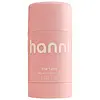What's inside
What's inside
 Key Ingredients
Key Ingredients

 Benefits
Benefits

 Concerns
Concerns

 Ingredients Side-by-side
Ingredients Side-by-side

Brassica Campestris Seed Oil
Skin ConditioningHelianthus Annuus Seed Oil
EmollientCocos Nucifera Oil
MaskingButyrospermum Parkii Butter
Skin ConditioningHelianthus Annuus Seed Wax
Skin ConditioningBehenyl Behenate
EmollientZea Mays Starch
AbsorbentSalvia Hispanica Seed Oil
MoisturisingPolyhydroxystearic Acid
EmulsifyingMyrica Cerifera Fruit Wax
EmollientSimmondsia Chinensis Seed Oil
EmollientSilica
AbrasiveTocopherol
AntioxidantCandelilla Cera
EmollientWater
Skin ConditioningGlycine Soja Oil
EmollientAloe Barbadensis Leaf Extract
EmollientCitric Acid
BufferingBrassica Campestris Seed Oil, Helianthus Annuus Seed Oil, Cocos Nucifera Oil, Butyrospermum Parkii Butter, Helianthus Annuus Seed Wax, Behenyl Behenate, Zea Mays Starch, Salvia Hispanica Seed Oil, Polyhydroxystearic Acid, Myrica Cerifera Fruit Wax, Simmondsia Chinensis Seed Oil, Silica, Tocopherol, Candelilla Cera, Water, Glycine Soja Oil, Aloe Barbadensis Leaf Extract, Citric Acid
Caprylic/Capric Triglyceride
MaskingTheobroma Cacao Seed Butter
EmollientCetearyl Alcohol
EmollientC13-15 Alkane
SolventBehenyl Behenate
EmollientHydrogenated Vegetable Oil
EmollientHelianthus Annuus Seed Wax
Skin ConditioningPolyhydroxystearic Acid
EmulsifyingCopernicia Cerifera Wax
Lauryl Laurate
Skin ConditioningPersea Gratissima Oil
Skin ConditioningSalvia Hispanica Seed Oil
MoisturisingHelianthus Annuus Seed Oil
EmollientPotassium Alum
AstringentCI 77220
Cosmetic ColorantCaesalpinia Sappan Extract
Skin ConditioningTocopherol
AntioxidantCaprylic/Capric Triglyceride, Theobroma Cacao Seed Butter, Cetearyl Alcohol, C13-15 Alkane, Behenyl Behenate, Hydrogenated Vegetable Oil, Helianthus Annuus Seed Wax, Polyhydroxystearic Acid, Copernicia Cerifera Wax, Lauryl Laurate, Persea Gratissima Oil, Salvia Hispanica Seed Oil, Helianthus Annuus Seed Oil, Potassium Alum, CI 77220, Caesalpinia Sappan Extract, Tocopherol
 Reviews
Reviews

Ingredients Explained
These ingredients are found in both products.
Ingredients higher up in an ingredient list are typically present in a larger amount.
We don't have a description for Behenyl Behenate yet.
Helianthus Annuus Seed Oil is the oil derived from the seeds of a Sunflower. Sunflower seed oil is non-fragrant. It is an emollient, meaning it helps to soften the skin.
Sunflower seed oil contains many fatty acids. The fatty acids found in sunflower seeds include (from highest amount to least): linoleic acid, myristic acid, palmitic acid, stearic acid, arachidic acid, oleic acid, and linolenic acid.
These fatty acids help the skin create ceramides. Ceramides play a role in repairing the skin barrier.
Helianthus Annuus Seed Oil helps moisturize the skin. This in turn helps the skin look more rejuvenated and smoother.
Sunflowers are rich in vitamin E.
Historians believe Indigenous cultures of North America domesticated sunflowers before corn. Thus they relied on sunflower oil for a variety of uses. One such use is moisturizing skin and hair.
Sunflower seed oil may not be fungal acne safe. We recommend speaking with a professional if you have any concerns.
Learn more about Helianthus Annuus Seed OilHelianthus Annuus Seed Wax is created from the common sunflower.
Sunflower seed wax is made up of long chain non-glyceride esters, a small amount of fatty alcohols, and fatty acids.
This ingredient is often used to enhance the texture of products. The fatty acid properties also help hydrate the skin.
Learn more about Helianthus Annuus Seed WaxPolyhydroxystearic Acid is a soft wax made from castor oil.
It is is a texture thickener, emulsifier, and film-former. Emulsifiers prevent ingredients from separating, such as oils and waters.
Polyhydroxystearic Acid may not be fungal acne safe.
Learn more about Polyhydroxystearic AcidSalvia Hispanica Seed Oil is an oil and isn't fungal acne safe.
Tocopherol (also known as Vitamin E) is a common antioxidant used to help protect the skin from free-radicals and strengthen the skin barrier. It's also fat soluble - this means our skin is great at absorbing it.
Vitamin E also helps keep your natural skin lipids healthy. Your lipid skin barrier naturally consists of lipids, ceramides, and fatty acids. Vitamin E offers extra protection for your skin’s lipid barrier, keeping your skin healthy and nourished.
Another benefit is a bit of UV protection. Vitamin E helps reduce the damage caused by UVB rays. (It should not replace your sunscreen). Combining it with Vitamin C can decrease sunburned cells and hyperpigmentation after UV exposure.
You might have noticed Vitamin E + C often paired together. This is because it is great at stabilizing Vitamin C. Using the two together helps increase the effectiveness of both ingredients.
There are often claims that Vitamin E can reduce/prevent scarring, but these claims haven't been confirmed by scientific research.
Learn more about Tocopherol